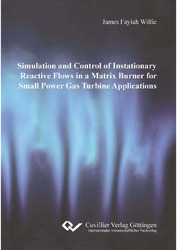| Fachbereiche | |
|---|---|
| Buchreihen (96) |
1378
|
| Nachhaltigkeit |
3
|
| Gesundheitswesen |
1
|
| Geisteswissenschaften |
2364
|
| Naturwissenschaften |
5406
|
| Ingenieurwissenschaften |
1793
|
| Allgemeine Ingenieurwissenschaften | 292 |
| Maschinenbau und Verfahrenstechnik | 862 |
| Elektrotechnik | 686 |
| Bergbau- und Hüttenwesen | 30 |
| Architektur und Bauwesen | 75 |
| Allgemein |
98
|
|
Leitlinien Unfallchirurgie
5. Auflage bestellen |
|
Erweiterte Suche
Simulation and Control of Instationary Reactive Flows in Matrix Burner for Small Power Gas Turbine Applications
James Fayiah Willie (Autor)Vorschau
Inhaltsverzeichnis, Datei (46 KB)
Leseprobe, Datei (510 KB)
The main objective of this thesis is to analyze combustion instabilities in a matrix
burner. The various tools that exist for analyzing thermoacoustic instabilities are
applied to the matrix burner with multiple flames. The principal goals are to determine
the primary causes of combustion instabilities in the burner and to explore
ways of controlling such instabilities in order to prevent damage to the burner.
To achieve these goals, the stability map of the burner obtained from measurements
is analyzed. This is followed by the analysis of the aerodynamics of the cold flow
using CFD. Results obtained from CFD are validated with PIV and LDA results
from measurements. Critical are the centerline axial velocity inside the combustion
chamber and the recirculation zones on the walls of the combustion chamber and
those between the various slots of the matrix burner.
Cold flow simulations are followed by reactive flow simulations for both gaseous and
liquid fuels. A detailed atomization model is developed for the liquid fuel case from
experimental data. Two combustion models, namely, the combined finite rate/eddy
dissipation model and the finite rate chemistry model are compared in the CFD
simulations of combustion instabilities and validation with measurements are done.
The latter is chosen over the former because it accounts for chemistry and it is not
numerically dissipative. Two CFD softwares, Fluent and CFX are also compared to
determine which is better at capturing acoustics. System identification using CFD
is used to determine the flame transfer function and the acoustic transfer matrix.
This is followed by the use of acoustic forcing and fuel modulation on the primary
and pilot in order to limit the amplitude of the instabilities inside the matrix burner
combustor.
The 1D acoustic network is used to determine the longitudinal eigenmodes of the
matrix burner. This is followed by the use of 3D finite element method (FEM) and
fluid-structure interaction (FSI) to determine whether a coupling exist between the
fluid and structure of the matrix burner combustor and vice versa.
Finally, Full harmonic analysis is performed for the rectangular combustor and the
results obtained are validated with analytical results. This is followed by the 3D
structure modal analysis of the full matrix burner test rig.
| ISBN-13 (Printausgabe) | 3954040018 |
| ISBN-13 (Printausgabe) | 9783954040018 |
| ISBN-13 (E-Book) | 9783736940017 |
| Buchendformat | A5 |
| Sprache | Englisch |
| Seitenanzahl | 186 |
| Umschlagkaschierung | matt |
| Auflage | 1 Aufl. |
| Band | 0 |
| Erscheinungsort | Göttingen |
| Promotionsort | Aachen |
| Erscheinungsdatum | 02.02.2012 |
| Allgemeine Einordnung | Dissertation |
| Fachbereiche |
Maschinenbau und Verfahrenstechnik
|
| Schlagwörter | Matrixbrenner, Verbrennungsinstabilitäten, Thermoakustik, CFD,Aktive Regelung, 1D-Akustiknetzwerk, FEM. |








